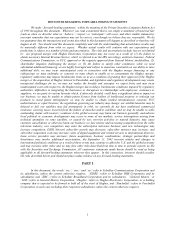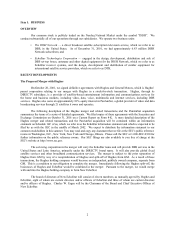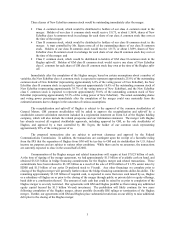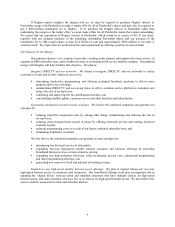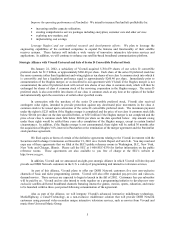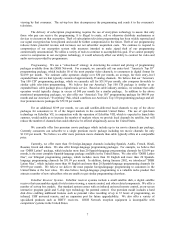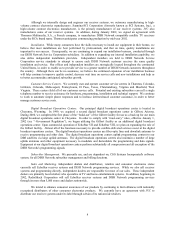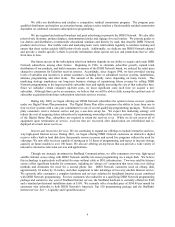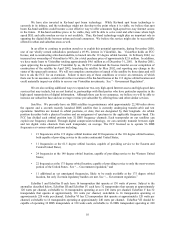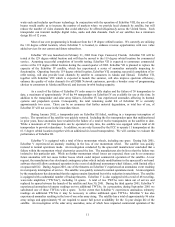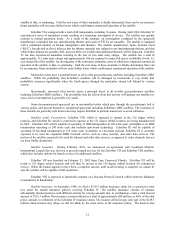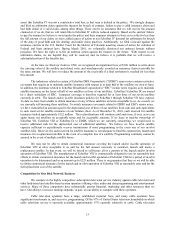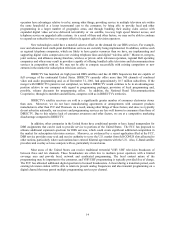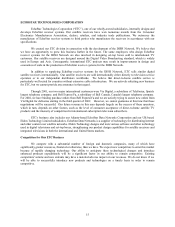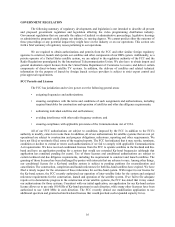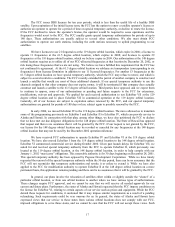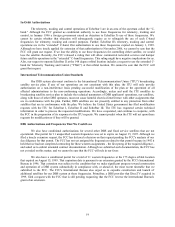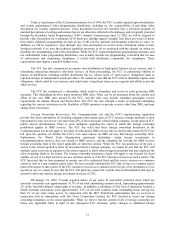Dish Network 2001 Annual Report Download - page 13
Download and view the complete annual report
Please find page 13 of the 2001 Dish Network annual report below. You can navigate through the pages in the report by either clicking on the pages listed below, or by using the keyword search tool below to find specific information within the annual report.11
watts each and includes spot-beam technology. In conjunction with the operation of EchoStar VIII, the use of spot-
beams would enable us to increase the number of markets where we provide local channels by satellite, but will
reduce the number of video channels that could otherwise be offered ubiquitously across the United States. Each
transponder can transmit multiple digital video, audio and data channels. Each of our satellites has a minimum
design life of 12 years.
Most of our core programming is broadcast from the 119 degree orbital location. We currently are utilizing
the 110 degree orbital location, where EchoStar V is located, to enhance revenue opportunities with new value
added services for our current and future subscribers.
EchoStar VII was launched on February 21, 2002 from Cape Canaveral, Florida. EchoStar VII will be
tested at the 129 degree orbital location and will then be moved to the 119 degree orbital location for commercial
service. Assuming successful completion of in-orbit testing, EchoStar VII is expected to commence commercial
service at the 119 degree orbital location during the second quarter of 2002. EchoStar VII is planned to replace the
capacity of the EchoStar IV satellite, which has experienced a series of anomalies materially impacting its
functionality. Operating from the 119 degree orbital location, EchoStar VII, assuming successful completion of in-
orbit testing, will also provide local channels by satellite to consumers in Alaska and Hawaii. EchoStar VII,
together with EchoStar VIII which is expected to launch this summer, will also improve spectrum efficiency,
enhance the quality of video channels for all DISH Network customers, provide a broader array of programming
choices to consumers in Alaska and Hawaii, and increase in-orbit backup capacity.
As a result of the failure of EchoStar IV solar arrays to fully deploy and the failure of 30 transponders to
date, a maximum of approximately 14 of the 44 transponders on EchoStar IV are available for use at this time. In
addition to the transponder and solar array failures, EchoStar IV has experienced anomalies affecting its thermal
systems and propulsion system. Consequently, the total remaining useful life of EchoStar IV is currently
approximately two years. There can be no assurance that further material degradation, or total loss of use, of
EchoStar IV will not occur in the immediate future.
During January 2002, a transponder pair on EchoStar III failed, resulting in a temporary interruption of
service. The operation of the satellite was quickly restored. Including the five transponders pairs that malfunctioned
in prior years, these anomalies have resulted in the failure of a total of twelve transponders on the satellite to date.
While a maximum of 32 transponders can be operated at any time, the satellite was equipped with a total of 44
transponders to provide redundancy. In addition, we are only licensed by the FCC to operate 11 transponders at the
61.5 degree orbital location (together with an additional six leased transponders). We will continue to evaluate the
performance of EchoStar III.
EchoStar V is equipped with a total of three momentum wheels, including one spare. During July 2001,
EchoStar V experienced an anomaly resulting in the loss of one momentum wheel. The satellite was quickly
restored to normal operations mode. An investigation conducted by the spacecraft manufacturer concluded that a
failure within the momentum wheel electronics caused the loss. The manufacturer also believes that the failure was
isolated to this particular unit. While no further momentum wheel losses are expected, there can be no assurance
future anomalies will not cause further losses which could impact commercial operation of the satellite. At our
request, the manufacturer has developed contingency plans which include modifications to the spacecraft’s on-board
software that will allow continued operation in the event of additional momentum wheel failures, with limited effect
on spacecraft life. During August 2001, one of the thrusters on EchoStar V experienced an anomalous event resulting
in a temporary interruption of service. The satellite was quickly restored to normal operations mode. An investigation
by the manufacturer has determined that the engine remains functional but with a reduction in rated thrust. The satellite
is equipped with a substantial number of backup thrusters. EchoStar V is also equipped with a total of 48 traveling-
wave-tube amplifiers (“TWTAs”), including 16 spares. A total of two TWTAs were taken out of service and
replaced by spares between the launch of the satellite and June 30, 2001. During the third quarter 2001, EchoStar V
experienced anomalous telemetry readings on two additional TWTAs. As a precaution, during September 2001 we
substituted one of those TWTAs with a spare. To the extent that EchoStar V experiences anomalous telemetry
readings on additional TWTAs it may be necessary to utilize additional spare TWTAs. EchoStar V has also
experienced anomalies resulting in the loss of one solar array string. The satellite has a total of approximately 96 solar
array strings and approximately 92 are required to assure full power availability for the 12-year design life of the
satellite. An investigation of the solar array anomalies, none of which have impacted commercial operation of the


